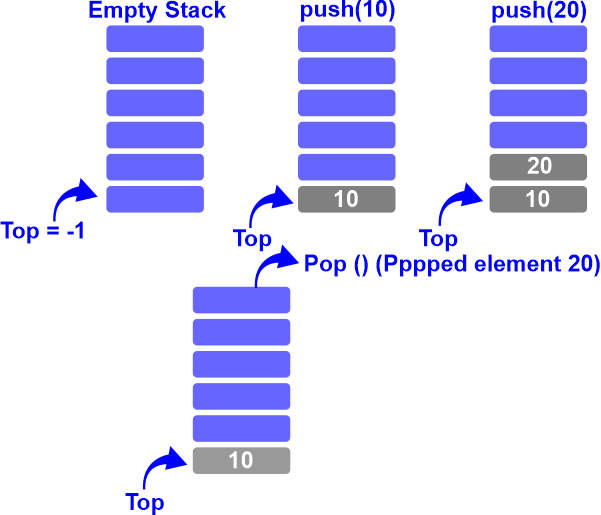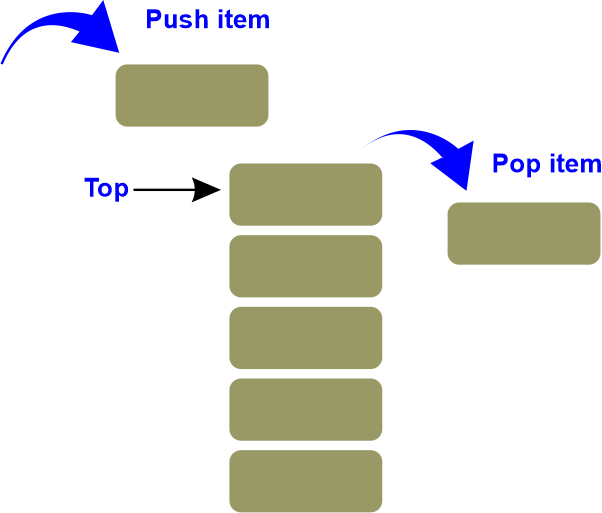Stack Operations in Data StructureWhat is a Stack?The Last-In-First-Out (LIFO) concept is used by Stacks, a type of linear data structure. The Queue has two endpoints, but the Stack only has one (front and rear). It only has one pointer, top pointer, which points to the stack's topmost member. When an element is added to the stack, it is always added to the top, and it can only be removed from the stack. To put it another way, a stack is a container that allows insertion and deletion from the end known as the stack's top. LIFO (Last in First out) MethodAccording to this method, the piece that was added last will appear first. As an actual illustration, consider a stack of dishes stacked on top of one another. We may claim that the plate we put last comes out first because the plate we put last is on top and we take the plate at the top. Due to the possibility of understating inventory value, LIFO is not a reliable indicator of ending inventory value. Due to increasing COGS, LIFO leads to reduced net income (and taxes). However, under LIFO during inflation, there are fewer inventory write-downs. Results from average cost are in the middle of FIFO and LIFO. Real Life Example of LIFOLet's say that business A sells 10 widgets. $100 per, the first five widgets were delivered two days ago. The remaining five widgets, which cost $200 apiece, just got here yesterday. The last items received are the first to go out on the market, according to the LIFO technique of inventory management. How much may the accountant put down as a cost even though seven widgets were sold? Although the income from each widget is the same because of its fixed sales price, the cost of each widget is determined by the inventory method used. The last item received is the first item sold according to the LIFO mechanism. Accordingly, the $200 widgets were the first to sell. Following that, the business sold two more of the $100 widgets. Five widgets are priced at $200 each, and two are priced at $100, for a total cost of $1,200 for the widgets using the LIFO approach. As opposed to FIFO, which sells the $200 widgets last, the $100 widgets are sold first. As a result, the price of the sold widgets, which breaks down to five at $100 and two at $200, will be reported as $900. That's why LIFO generates bigger profits during price-increasing periods. Because of this, LIFO increases expenses during times of price growth and decreases net revenue, which also lowers taxable income. Similar to this, LIFO reduces expenses and raises net income during periods of declining prices, which also raises taxable revenue. Operations on StackCertain actions are made available to us so that we can manipulate a stack.

push()It stacks up a new item. A stack overflow circumstance is when the stack is completely full. Algorithm for push(): pop()It takes something out of the stack. In the opposite sequence from which they were pushed, the things are popped. The condition is referred to as an underflow if the stack is empty. Algorithm for pop(): top()It returns the stack's top element. 
Algorithm for top(): isempty()The answer is true if the stack is empty and false otherwise. Algorithm for isempty(): Practical knowledge about stackThere are several instances of stacks in everyday life. Take the straightforward illustration of dishes stacked on top of one another in a canteen. The plate that is placed at the bottom of the stack stays there for the greatest amount of time since the plate at the top is the first to be taken out. Therefore, it is clear that it adheres to the LIFO/FILO order. Analysis of ComplexityVarious Stack Types
Some Stack Applications
Implementing a stack may be done in one of two ways
Implementation of Stack using Array:OUTPUT: 10 pushed into stack 20 pushed into stack 30 pushed into stack 30 Popped from stack Top element is : 20 Elements present in stack : 20 10 ........................................................... Process executed in 3.22 seconds Press any key to continue. Advantages of Implementation of Stack using Array:
Disadvantage of Implementation of Stack using Array:
Implementation of Stack using Linked List:OUTPUT: 10 pushed to stack 20 pushed to stack 30 pushed to stack 30 popped from stack Top element is 20 Elements present in stack : 20 10 ........................................................... Process executed in 3.22 seconds Press any key to continue. Advantages of Implementation of Stack using Linked List:
Disadvantage of Implementation of Stack using Linked List:
Implementation of Stack using Singly Linked ListAll single linked list activities should be carried out according to stack operations LIFO (last in first out), and with the aid of that understanding, we are going to create a stack using a singly linked list. push()
pop()
peek()
display()
Example: OUTPUT: Stack Size : 4 Top Element : 4 Stack as linked List 4-->3-->2-->1 Removed Element : 4 Removed Element : 3 Removed Element : 2 Removed Element : 1 Stack is Empty .................... Process executed in 4.43 seconds Press any key to continue
Next TopicSelf-Balancing Binary Search Trees
|
 For Videos Join Our Youtube Channel: Join Now
For Videos Join Our Youtube Channel: Join Now
Feedback
- Send your Feedback to [email protected]
Help Others, Please Share









